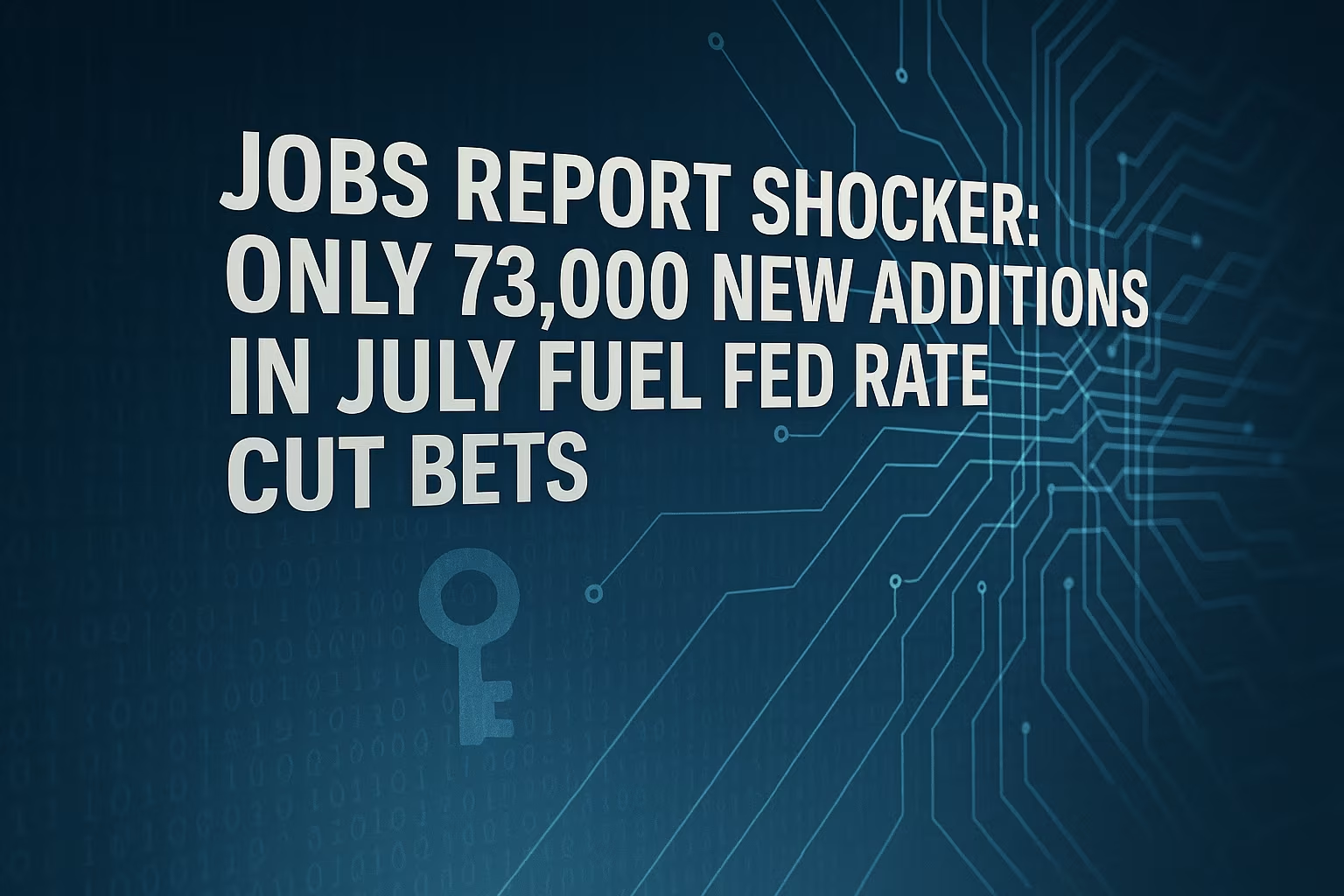In a stunning turn of events, the U.S. labor market added only 73,000 new jobs in July, falling far short of Wall Street’s expectations and raising urgent questions about the trajectory of the economy. Economists had forecasted upwards of 175,000 new hires, making the shortfall the biggest jobs report miss in over two years. As the data hit news wires, investors quickly shifted their expectations — not toward higher interest rates to tame inflation, but toward imminent rate cuts from the Federal Reserve.
The weaker-than-expected jobs report may indicate a more significant cooling in the labor market than previously thought, providing new ammunition for those urging a monetary policy pivot. Although unemployment held steady at 4.0%, the underwhelming headline figure adds pressure on the Fed to reassess its stance as growth risks start to materialize more visibly.
A Sharp Slowdown Signals Economic Fatigue
July’s paltry job growth represents a dramatic deceleration from June’s revised figure of 156,000. It’s not just a month-over-month dip — it may be a signal that labor demand is losing steam across multiple sectors. Industries that had been stalwart job creators over the past year, such as healthcare, construction, and hospitality, either pulled back or posted marginal gains. Notably, retail and manufacturing sectors saw outright declines in employment.
The Bureau of Labor Statistics (BLS) also reported a downward revision to May and June figures by a combined 59,000 jobs, adding further weight to the notion that the labor market is not just plateauing but beginning to roll over.
Market Reaction: Rate Cut Bets Surge
Financial markets wasted no time in pricing in a shift. Fed Funds futures now imply a 60% chance of a rate cut at the central bank’s September meeting, a dramatic increase from just 28% prior to the report. The yield on the 10-year Treasury note dropped below 4.0% for the first time since April, while the U.S. dollar weakened against a basket of major currencies. Meanwhile, equity markets rallied on hopes that easing policy could soften the blow of an economic slowdown.
“We’re seeing a classic bad-news-is-good-news response,” said Dana Patel, senior economist at CapitalEdge. “Weak labor data reduces the risk of further tightening, and that gives equities some breathing room. But it also underlines that growth is losing momentum.”
Wage Growth Slows — A Win for Inflation, a Worry for Workers
Another key component of the report was average hourly earnings, which grew just 0.2% month-over-month and 3.9% year-over-year — a decline from the previous month’s 4.1% pace. While slowing wage growth might help the Fed in its battle against inflation, it also raises concerns about consumer spending power, especially as prices in essentials like housing, food, and healthcare remain elevated.
The labor force participation rate held steady at 62.6%, indicating that while more Americans aren’t necessarily dropping out of the workforce, employers are clearly pulling back on hiring. Small businesses and mid-sized firms appear to be most affected, with rising costs and softening demand leading to more cautious hiring strategies.
Sector-by-Sector Breakdown: Uneven Pain
- Professional and Business Services: The sector lost 21,000 jobs in July, its worst monthly performance since early 2021. Consulting and temporary help services saw the steepest cuts.
- Retail Trade: Shed 14,000 jobs, driven by weaker-than-expected back-to-school season hiring and continued pressure from online competition.
- Manufacturing: Lost 8,000 jobs as global demand weakened and inventories remained high.
- Leisure and Hospitality: Added just 11,000 jobs, a sharp slowdown from recent months as post-pandemic hiring normalizes.
- Healthcare: One of the few bright spots, the sector added 34,000 jobs, although even this was a step down from its previous growth pace.
Fed’s Balancing Act Becomes More Precarious
Federal Reserve Chair Jerome Powell has repeatedly stressed the importance of incoming data in guiding monetary policy. With inflation easing and the labor market now showing signs of strain, the case for holding or cutting rates gains strength. Still, some Fed officials have warned against moving too quickly, arguing that inflation could flare up again if the central bank becomes too accommodative too soon.
July’s report will likely feature prominently in discussions during the Fed’s upcoming Jackson Hole Economic Symposium, where Powell and global policymakers gather to assess macroeconomic challenges. If subsequent data points — particularly August’s employment report and inflation metrics — continue to soften, the Fed could signal a policy shift as early as its September meeting.
Consumer and Business Sentiment at a Crossroads
The weak jobs report comes on the heels of declining consumer confidence and a recent dip in small business optimism. The University of Michigan’s Consumer Sentiment Index fell to a three-month low, as households grew more concerned about job stability and income prospects.
For businesses, especially those relying on discretionary spending, the implications are sobering. Slowing wage growth and job creation typically translate into softer demand, making future earnings projections more uncertain. Analysts have already begun revising Q3 GDP growth forecasts downward, with some estimating sub-1.5% annualized expansion.
Political Fallout Ahead of the 2026 Midterms
The jobs report has also added fuel to political debates. Critics of the Biden administration argue that high interest rates and excessive regulation are stifling growth, while supporters claim the labor market’s resilience up to this point validates the administration’s economic strategy. With the 2026 midterm elections just over a year away, economic performance will likely be a dominant issue.
Expect the White House and Congress to pivot toward discussions of job stimulus, tax incentives for hiring, and infrastructure spending, especially if future reports continue to disappoint.
Recession Fears Return, But Not All Hope Is Lost
While July’s figures were undeniably weak, most economists stop short of declaring a recession imminent. The broader labor market, though cooling, remains historically tight, and key sectors like healthcare and tech are still expanding. Additionally, consumer balance sheets remain relatively healthy, and corporate earnings — while mixed — have not collapsed.
Still, July’s jarring report underscores the fragile state of the recovery. Without a rebound in job creation and wage growth, the Fed may have to act sooner than anticipated to support demand.
As Wall Street, Washington, and Main Street digest the data, the message is becoming clearer: the labor market is no longer immune to broader economic pressures, and the policy pivot many expected in late 2025 may now arrive ahead of schedule.





